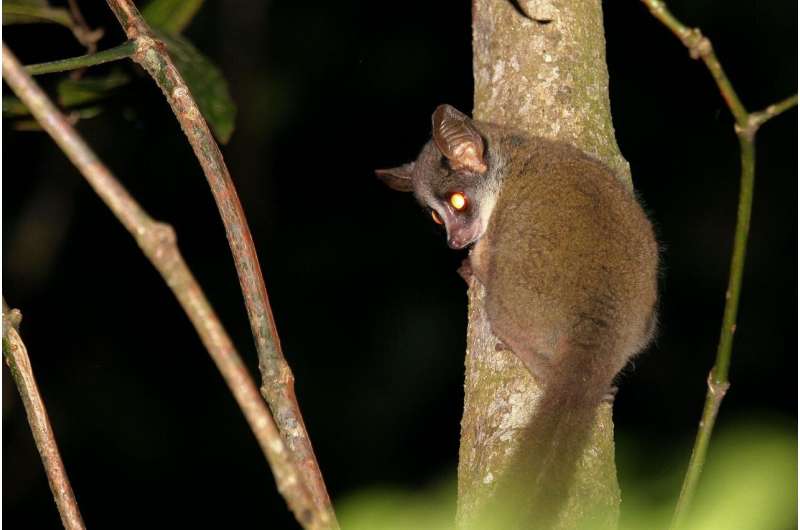Enigmatic small primate finally caught on film in Taita, Kenya

Good news from the Kenyan Taita Hills: the Taita mountain dwarf galago still survives. This was confirmed by researchers working at the University of Helsinki Taita Research Station.
The tiny nocturnal prosimian, weighing only 100-180 grams, was first reported in 2002, but no sightings had been made since.
The dwarf galagos in the Taita Hills live in relatively cool montane forests at the altitude of 1,400-1,950 metres. They—as do all the dwarf galago species—live in small family groups and communicate using several types of calls. Because all dwarf galago species look similar, they are most conveniently identified on the basis of their distinctive calls.
Finding the small nocturnal animal is challenging, as the forest canopy is in places up to 50 metres high. The animals are spotted with a red light not visible to the animal itself.
"The tropical forest is magically beautiful at night, but one is lucky to catch even a glimpse of the tiny creatures," says University of Helsinki Ph.D. student Hanna Rosti who has spent hours observing and recording the animals.
"Dwarf galagos make agile jumps from tree to tree and feed on moths, cicadas and other insects. I have seen them hunting above ground-dwelling safari ants, where they obviously take advantage of insects fleeing from the voracious ants."
Unfortunately, the tiny mammal seems to be at the verge of extinction.
"The future of Taita mountain dwarf galagos and other endemic animal and plant species depends on the future of native montane forests of the Taita Hills. The conservation status of the forests must be strengthened and their area should be expanded by planting native trees in areas destroyed by cutting and fire. This will protect galago habitats and will ensure that the montane forests continue to provide many vital ecosystem services," says Professor Jouko Rikkinen from the University of Helsinki. He has been studying the biota of the Taita Hills since 2009.
Many animals and plants of the local montane forests have evolved in isolation and the number of endemic species is remarkably high. The Taita Hills belong to the Eastern Arc Mountains, which represent a global biodiversity hotspot.
The diversity of the Taita Hills will never stop surprising Professor Petri Pellikka, the director of the Taita Research Station. "The mountains represent a living laboratory, with great possibilities for ground-breaking research and fascinating new findings."
More information: Hanna Rosti et al, Taita Mountain dwarf galago is extant in the Taita Hills of Kenya, Oryx (2020). DOI: 10.1017/S003060531900142X
Journal information: Oryx
Provided by University of Helsinki
















